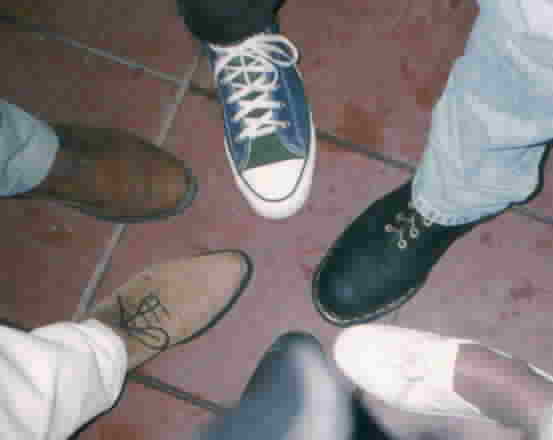
Usage I: Worldwide, shoes are among the most expressive of all nonverbal cues (see also HAT). This reflects a. the foot's primate evolution as a grasping organ (i.e., as a neurological "smart part"), and b. the curious fact that our foot's sensory mapping on the brain's parietal lobe abuts that of the genital organs (i.e., our feet are similarly sensitive, ticklish, and sexy; see HOMUNCULUS).
Usage II: Frequently, feminine footwear shows personality and uniqueness (and says, e.g., "I'm someone special"), while masculine footwear is part of a uniform to mark membership in a group (to say, e.g., "I'm on the management team," or "I'm a cowboy").
Archaeology I. The oldest indirect evidence for footwear may be found in a Spanish Upper Paleolithic cave painting of a man clad in animal-skin boots and a woman clad in furry boots, dating to between 14,000 and 17,000 years ago. The oldest footwear yet unearthed is a 10,000-year-old sagebrush-bark sandal, with straps running around the heel and over the top of the foot. Like the foot's sole itself, the bottom was ridged for better traction (as are, e.g., Birkenstocks today). About 2,200 years ago, the Romans made shoes more comfortable by adapting them to the actual shapes and sizes of feet. About 1,300 years ago, Arabs in Cordova, Spain, introduced shoes made of tanned leather, the favored material of most shoes today.
Archaeology II. Humans have been decorating their sandals and
shoes at least since the beginning of the Neolithic Age, ca. 10,000 years ago.
According to archaeologists who found them in homes, tombs, and burials, the
earliest sandals came in hundreds of designs. Thus, style in
footwear was important from the very beginning, just as it is
today.
Culture. In the Middle East, Singapore, and Thailand,
showing the sole of a shoe (while sitting down), accidentally or deliberately,
to another person is an insult. The sole-show is insulting because ". . .
the bottom of the shoe is seen as the lowliest part of the body, the part that
steps in dirt" (Morris 1994:77).
Evolution. As a rule, shoes evolve at a slower rate than clothing.
Women's shoes change more frequently--and far more
dramatically--than men's shoes.
Fetish. ". . . shoes are the
clearly visible yet strangely private vocabularies of our fantasies, our private
fetishes. They are the subject of what psychologists consider Western culture's
most common sexual fetish, a fetishism that spreads beyond those overt souls who
only enjoy love when it wears insanely constricting, wildly spiked heels"
(Kastor 1994:30).
Folklore. "'In the case of female symbolism, I
think the shoe is pretty explicit,' says Alan Dundees, professor of anthropology
and folklore at the University of California at Berkeley. 'The foot fitting in
the shoe--you have the act, the same as putting a finger through a ring. There's
some actual iconic representations of the sexual act here'" (Kastor 1994:30).
See also BOOT, GOOSE-STEP, HIGH HEEL, SNEAKER.
YouTube Video: Dancing ShoesCopyright 1998 - 2016 (David B. Givens/Center for Nonverbal Studies)
"Circle of Friends and Footwear" (San Diego, California, USA; photo credit: David B. Givens [copyright 2000])